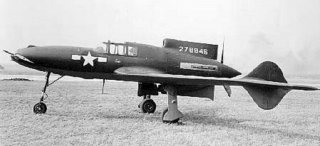XP-55 Ascender: Interesting Looking, But One Really Mediocre Plane
Though never a spectacular plane, XP-55 Ascender was interesting to look at—but not to fly. That it never entered production is probably for the best.
Here's What You Need To Remember: The performance was disappointing. Its contemporary airframes were faster and handled better, partially dooming the Ascender’s development. The other factor was the jet engine. When the XP-55 Ascender was still in the testing and prototype stage in 1944, jet engines were already recognized as the future of aerial warfare.
In 1939, the Army put out a call for tenders, asking aircraft manufacturers to design an airframe that was superior to existing planes with a focus on speed and the pilot’s line of sight. It also specified that radical and unconventional aircraft designs would be allowed—thankfully for the Curtiss-Wright XP-55 Ascender.
The Ascender used a pusher-style propeller located at the rear that “pushed” rather than “pulled” the airframe. One of its more unique features was that it had a lever in the cockpit for ditching the propeller in case the pilot needed to bail from the plane. Due to the pushed design, the plane was jokingly called the “Ass-ender.”
The pusher design was an odd choice. Due to the engine being in the rear of the plane, cooling was an issue. Overheating was apparently a problem if the Ascender spent too much time taxiing before takeoff.
Perhaps unsurprisingly, the XP-55 Ascender suffered from poor handling characteristics. It stalled with little to no warning and needed a great deal of altitude to recover. On the Ascender’s first flight, it flipped onto its back, falling for over 10,000 feet before recovering.
The plane was in essence a flying wing, as it had only very minimal vertical control surfaces on the outside of the wings and the rear of the fuselage with which to maneuver.
During testing, it was discovered that the XP-55 Ascender required very long runways to take off. The two winglets or canards on the nose of the plane were an attempt to improve the takeoff flight characteristics of the plane and were attached to mimic the angle of the plane’s flaps during takeoff.
A ladder was stored in the cockpit behind the pilot’s seat, which telescoped inward and outward to help entering and exiting the awkward plane.
Entering the Jet Age
The performance was disappointing. Its contemporary airframes were faster and handled better, partially dooming the Ascender’s development. The other factor was the jet engine. When the XP-55 Ascender was still in the testing and prototype stage in 1944, jet engines were already recognized as the future of aerial warfare.
Though turboprops are capable in their own right, jet engines easily surpass turboprops in performance. A turboprop will struggle to reach Mach 1, whereas a jet-powered airplane can exceed Mach 2. The XP-55 Ascender—and propeller-driven airframes writ large—were over.
Though never a spectacular plane, XP-55 Ascender was interesting to look at—but not to fly. That it never entered production is probably for the best.
Caleb Larson holds a Master of Public Policy degree from the Willy Brandt School of Public Policy. He lives in Berlin and writes on U.S. and Russian foreign and defense policy, German politics, and culture. This article first appeared earlier this year.
Image: Wikimedia Commons.

